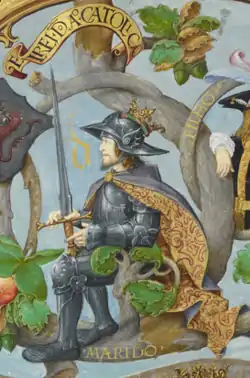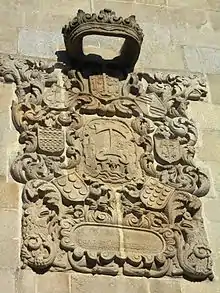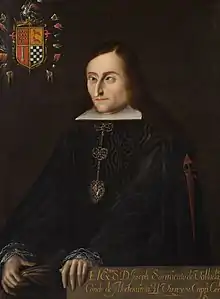House of Romay
The House of Romay (Spanish: Casa de Romay) is a Spanish aristocratic family that descends from 8th-century nobility of pre-Reconquista Galicia, in northern Spain. According to historians, it descends from King Alfonso I the Catholic, through his natural grandson Infante Román de Romaes, Count of Monterroso and Santa María de Hortigueira.[1] The principal family seats are the Palace of Cadro and the Castle of Sotomayor,[2] both in Pontevedra, Galicia.

The current head of the family is Don Ricardo de Romay y Hernandez-Chazaro, 44th Count of Monterroso, 47th Señor de Cadro and Monterroso.[3]
Origins

The Romay family's origins precede historical records, dating back to the Roman occupation in the area, and for this reason the family was awarded the distinction of Hidalgo de Sangre to its members in the legitimate male line,[4] with the title of Don (Lord) for junior members and the denomination "Most illustrious" (Ilustrisimo Señor (male), abbreviated Ilmo. Sr., or Ilustrisima Señora (female), abbreviated Ilma. Sra.) or the honorific prefix of "The Most Excellent" (Excelentísimo Señor (male), abbreviated Excmo. Sr., or Excelentísima Señora (female), abbreviated Excma. Sra.) for the heads of the different branches of the family and their consorts, depending on the title.
The indisputable line can be traced from the 13th-century records that coincide with the edification of the main family seat, the Palace of Cadro (Galician: Pazo do Cadro), in Marín, Galicia. This is the oldest pazo in that region.
History
![]()
![]()
![]()
![]()
![]()
![]()
![]()
The House of Romay is distinguished by its multiple alliances with noble families, such as Sarmiento de Valladares, Suárez de Deza, Saavedra, Mendoza, Montenegro, Ulloa, Varela, Fernández de Córdoba, Duque de Estrada, Osorio de Moscoso and Sotomayor, among other prominent aristocratic dynasties, from which descend the Dukes of Olivares, Dukes of Santangelo, Dukes of Medinanceli, Dukes of Bejar, Dukes of Atrisco, Dukes of Sessa, Dukes of Osuna and Dukes of Alba, to name a few.
Prominent members of the House of Romay:
- Don Jose Sarmiento Valladares Arines de Romay (1643-1708), 1st Duke of Atrisco, 40th Viceroy of New Spain
- Don Juan de Romay, 18th Count of Monterroso, Lord of Cadro.
- Doña Antonia de Romay-Sotomayor y Varela-Ulloa, Countess of Villanueva de San Bernardo
From whom descend the Marquises of Castro Serna and Counts of Adanero, and with the marriage between the current Duchess of Arcos (heiress to the Dukedom of Osuna) and the XI Marquess of Castro, also the future Dukes of Osuna.
- Doña Josefa de Romay y de España, Grandee of Spain, Baroness of Casa do Ria[5]
From whom descend the Marquesses of San Martín de Hombreiro.

- Don Alonso Enriquez Sarmiento Valladares y Romay (1700-1757) IV Marquess of Valladares, III Viscount Meira[5]
From whom descend the Marquesses of Mos and Valladares.
- Doña Ines de Arines Troncoso y Romay, Lady of Camos and of Casa de las Torres Blancas[5]
From whom descend the Dukes of Atrisco, Marquesses of Valladares and Mos and the Viscounts of Meira.
- Doña Juana de la Torre de Romay-Sotomayor, II Marquise de Bendaña
From whom descend the Marquesses of Bendaña.
- Ramón Romay y Ximenez de Cisneros (1764 -1849), Captain General of the Spanish Navy and Director General of the same in the mid-nineteenth century.
- José Alfonso Correa Cortés de Mendoza Ozores de Sotomayor y Romay, II count of Villanueva de San Bernardo, II viscount of Pegullal, etc.
- Antonio Fernández de Córdoba Romay
- Don Teodosio de Romay, Count of Monterroso, Lord of Cadro[3]
- Leonor Romay Yáñez-Sotomayor, Countess de la Torre Vilariño
- José Manuel Romay y Beccaria, Spanish politician.
 Coronet of the Counts of Monterroso
Coronet of the Counts of Monterroso - Tomas Romay y Chacon, doctor of the Royal Chamber and Knight Commander of the Order of Isabel la Católica (grandson of the Counts of Casa Bayona).
- Don Diego de Romay, VIII Marquess of Camos, designer and architect.[6]
- Doña María Romay Torrado, XVI Viscountess of La Pedreira
- Don Enrique de Romay y Piña, XLII Count of Monterroso, Lord of Cadro.
The last heads of the House of Romay have maintained residence in Mexico:[7]
- Don Ricardo de Romay y Wisbrun Chacon, XLIII Count of Monterroso, XLVI Lord of Cadro and Monterroso,[3] married in Mexico City in 1948 with Doña Ofelia Hernandez-Chazaro Lemus de Mier, (scion of the Dukes of Mier and Counts of Heras Soto, and cousin of Rainier III, Prince of Monaco on the Mier-Polignac line).[8] They had six children, among them Don Ricardo de Romay y Hernandez-Chazaro, who succeeded to the title in 2018.[3]
- Don Ricardo de Romay y Hernandez-Chazaro (1951), XLIV Count of Monterroso, XLVII Lord of Cadro and Monterroso, married Doña Marcela Basail Heredia von Habsburg-Lorraine[2] (1951), a direct descendant of Emperor Leopold II of Austria, Grand Duke of Tuscany, and of King Charles III of Spain, King of Naples and Sicily, Duke of Parma.[9] They had four children: Don Narian de Romay-Basail (1976), Don Jesus de Romano de Romay-Basail (1978), Don Ricardo de Romay-Basail (1981) and Don Diego de Romay-Basail (1988).[10]
Dominion and influence
_c._1697-1701.jpg.webp)
The best preserved registered settlement of the Romay family can be found in the archives of the 13th-century Palace of Cadro, the original family seat in Marin, Pontevedra, where they exercised civil and criminal jurisdiction.[11] They also ruled the Castle-Fortress del Monte, near Padron; the Palace of El Rosal in Morrazo, as well as the lordships of Adam, Seixo, Marín de Arriba and other dominions in that region, where government archives document that “the House of Romay can be traced back to the beginning of The Reconquista”, in other words before the year 711.[12]
In New Spain, the family amassed a considerable dominion as a result of their political influence in the colonies, with members such as the 1st Duke of Atrisco that held the uppermost rank of Viceroy of New Spain. The current and 47th title holder, Don Ricardo de Romay, inherited in 2018 one of the largest property holdings in Mexico, mostly concentrated in the Yucatán Peninsula, passed down from his ancestor the first Duke.[13]
Arms

The first record of the Romay heraldic arms can be found in the Castle-Fortress of Romay in Tras do Rio, in Frieiro, in the district of San Julian de Romay, Portas. As far as the armoury is concerned, the most ancient depiction dictates: «Coronet: That of a Lord. Crest: in a silver field a Lion Rampant Gules, under whose claws two Fig Leaves Saber and an ‘M' Gules under a Comital Coronet Or”.[14]
The crowned M and the Lion Rampant in Or allude to the royal lineage of King Alfonso I.[15]
References
- Dinastía Cánttabra (Linea 1a)
- Asociación de Genealogía, Heráldica y Nobiliaria de Galicia. "Proyecto Galicia: Heráldica, Genealogía y Nobiliaria", Ercules de Ediciones. p.66
- E. Pardo de Guevara, La memoria genealógica y el orgullo de linaje en un instrumento de 1509, “Nobiltà”, 70 (2006), pp. 103-127.
- E. Pardo de Guevara, «La memoria genealógica y el orgullo de linaje en un instrumento de 1509», Nobiltà, 70 (2006), pp. 142-3
- Registro de los Grandes de España
- María Dolores Vila Jato, "El patrimonio histórico de la Universidad de Santiago de Compostela", USC p. 44
- Asociación de Genealogía, Heráldica y Nobiliaria de Galicia. "Proyecto Galicia: Heráldica, Genealogía y Nobiliaria", Ercules de Ediciones. p.65
- La dinastia dei Grimaldi: settecento anni di storia e leggenda del Principato di Monaco, Enrica Roddolo, Publisher Piemme (1997) Tomo 1 pagina 146-48
- Wandruszka, Adam (1975). The House of Habsburg: Six Hundred Years of a European Dynasty. Greenwood Press. pp. 156–157.
- Asociación de Genealogía, Heráldica y Nobiliaria de Galicia. "Proyecto Galicia: Heráldica, Genealogía y Nobiliaria", Ercules de Ediciones. p.68
- Crespo, José Santiago. Blasones y Linajes de Galicia. Ediciones Boreal. La Coruña, 1984. Tomo IV, página 213
- Alfredo Perez Lara, El pazo y la historia de Galicia, Heraldo de Pontevedra, 90 (2003), pp. 73
- (in Spanish) "Sarmiento y Valladares, José," Enciclopedia de México, v. 12. Mexico City, 1988 p. 56
- Valero de Bernabé Luis y Eugenio, Martín de. Simbología y diseño de la heráldica gentilicia galaica, Heráldica (2003) Madrid.
- Asociación de Genealogía, Heráldica y Nobiliaria de Galicia. "Proyecto Galicia: Heráldica, Genealogía y Nobiliaria", Ercules de Ediciones. p.67
External links
- Diputación de la Grandeza de España (in Spanish)
- Registro de los Grandes de España:. (in Spanish)
- Dinastía de Cantabia (1a Línea) (in Spanish)
- Romay en Betanzos (in Spanish)
Part of a series on the |
|---|
| History of Spain |
 |
| Timeline |
|

